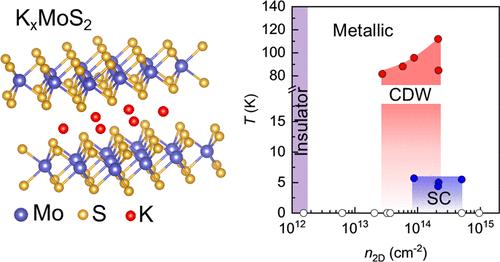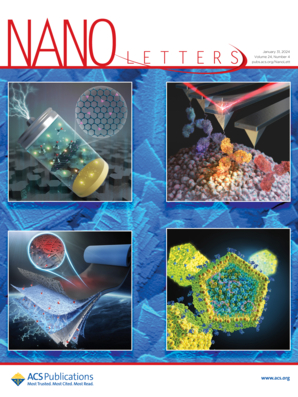二硫化钼中的栅极控制钾互锁和超导性
IF 9.6
1区 材料科学
Q1 CHEMISTRY, MULTIDISCIPLINARY
引用次数: 0
摘要
将客体离子插层到层状材料的范德华(vdW)间隙中是创造新型材料相和功能的有力途径。离子门控是一种控制离子运动和构型的技术,可用于插层和表面静电掺杂。离子门控技术的进步使我们能够对离子扩散、载流子掺杂和传输特性的动态进行原位探测。在此,我们对单晶 MoS2 的钾离子(K+)插层进行了原位电阻率和拉曼实验,并构建了温度-载流子密度相图。K+ 插层诱导了从棱柱配位相到八面体配位相的结构转变,在这一转变中观察到了各向异性的三维超导性和可能的电荷密度波态。目前的离子门控提供了对插层相的全面认识,并证明静电诱导的超导性与插层相的超导性截然不同。本文章由计算机程序翻译,如有差异,请以英文原文为准。

Gate-Controlled Potassium Intercalation and Superconductivity in Molybdenum Disulfide
Intercalation of guest ions into a van der Waals (vdW) gap in layered materials is a powerful route to create novel material phases and functionalities. Ionic gating is a technique to control the motions and configuration of ions for both intercalation and surface electrostatic doping. The advance of ionic gating enables the in situ probe of dynamics of ion diffusion, carrier doping, and transport properties. Here we performed in situ resistivity and Raman experiments on the potassium ion (K+) intercalation of single-crystal MoS2 and constructed a temperature–carrier density phase diagram. The K+-intercalation induces a structural transition from the prismatically coordinated phase to the octahedrally coordinated phase, where anisotropic three-dimensional superconductivity and a possible charge density wave state were observed. The present ionic gating offers a comprehensive view of the intercalated phases and proves that the electrostatically induced superconductivity is distinct from that in the intercalated phase.
求助全文
通过发布文献求助,成功后即可免费获取论文全文。
去求助
来源期刊

Nano Letters
工程技术-材料科学:综合
CiteScore
16.80
自引率
2.80%
发文量
1182
审稿时长
1.4 months
期刊介绍:
Nano Letters serves as a dynamic platform for promptly disseminating original results in fundamental, applied, and emerging research across all facets of nanoscience and nanotechnology. A pivotal criterion for inclusion within Nano Letters is the convergence of at least two different areas or disciplines, ensuring a rich interdisciplinary scope. The journal is dedicated to fostering exploration in diverse areas, including:
- Experimental and theoretical findings on physical, chemical, and biological phenomena at the nanoscale
- Synthesis, characterization, and processing of organic, inorganic, polymer, and hybrid nanomaterials through physical, chemical, and biological methodologies
- Modeling and simulation of synthetic, assembly, and interaction processes
- Realization of integrated nanostructures and nano-engineered devices exhibiting advanced performance
- Applications of nanoscale materials in living and environmental systems
Nano Letters is committed to advancing and showcasing groundbreaking research that intersects various domains, fostering innovation and collaboration in the ever-evolving field of nanoscience and nanotechnology.
 求助内容:
求助内容: 应助结果提醒方式:
应助结果提醒方式:


